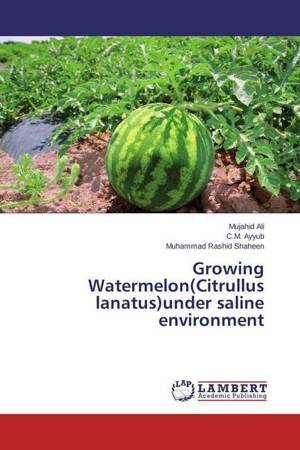
Je cadeautjes zeker op tijd in huis hebben voor de feestdagen? Kom langs in onze winkels en vind het perfecte geschenk!
- Afhalen na 1 uur in een winkel met voorraad
- Gratis thuislevering in België vanaf € 30
- Ruim aanbod met 7 miljoen producten
Je cadeautjes zeker op tijd in huis hebben voor de feestdagen? Kom langs in onze winkels en vind het perfecte geschenk!
- Afhalen na 1 uur in een winkel met voorraad
- Gratis thuislevering in België vanaf € 30
- Ruim aanbod met 7 miljoen producten
Zoeken
Growing Watermelon(Citrullus lanatus)under saline environment
Mujahid Ali, C. M. Ayyub, Muhammad Rashid Shaheen
Paperback | Engels
€ 54,95
+ 109 punten
Omschrijving
Watermelon (Citrullus lanatus Thanb. Mavs.) is a monoecious, cross-pollinated crop, annual, one of the twelfth species from the family Cucurbitaceae, a major vegetable crop family. Area of Pakistan under watermelon production is about 30,000 hectares having production of 150,000 tons annually. Overall, Pakistan stands on 25th position in the world in term of watermelon production and 17th position on area vise with area of 27,200 hectares and produces 406,000 tons of it annually. A loss of PKR 20 million per year has been estimated on the salt affected soils of Pakistan because of decrease in agricultural products. About 6.67 million hectares of land in Pakistan is salt-affected and about 1.89 hectares is saline. An area of about 1.85 million hectares is permeable to saline-sodic and 1.39 million hectares is impermeable saline-sodic and naturally 0.028 million hectares is sodic while in Punjab 2.22 million hectares saline patches. There was a dire need to work on the issue to fill the gape between the potential and actual yield owing to abiotic stresses.
Specificaties
Betrokkenen
- Auteur(s):
- Uitgeverij:
Inhoud
- Aantal bladzijden:
- 96
- Taal:
- Engels
Eigenschappen
- Productcode (EAN):
- 9783659788918
- Verschijningsdatum:
- 24/10/2015
- Uitvoering:
- Paperback
- Afmetingen:
- 150 mm x 6 mm
- Gewicht:
- 145 g

Alleen bij Standaard Boekhandel
+ 109 punten op je klantenkaart van Standaard Boekhandel
Beoordelingen
We publiceren alleen reviews die voldoen aan de voorwaarden voor reviews. Bekijk onze voorwaarden voor reviews.









